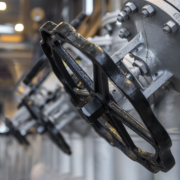FAQ – NESS NPK40
Sample Cooler NPK40 for taking samples of thermal oil
In this FAQ-area, you can read some general questions and answers around the NESS Sample Cooler NPK40, which advantage you can take of it and what you generally should consider for integration. In addition, it has to do with the infrastructure that should be given for successful operation.
- What does the NESS Sample Cooler do?
- How do I integrate the NESS Sample Cooler in my system?
- Do I need additional infrastructure for the operation of the sample cooler?
- How do I proceed for taking samples?
- What do I have to observe for the maintenance of the sample cooler?
- Is it possible to install it outdoors?
What does the NESS Sample Cooler do?
Using the NESS Sample Cooler, the oil sample can be taken under closed and cooled condition. It functions as a heat exchanger in which the medium flows through stainless-steel spiral tubes installed in a cooling water jacket.
Back to Index
How do I integrate the NESS Sample Cooler in my system?
No problem at all! Like all NESSessities, also the NESS Sample Coolers are designed as individual modules. Existing processes are not influenced. This concept allows an easy retrofitting also for already existing systems.
For instance, it is installed by means of one of our installation kits on the manometer valve on the outlet side using a T-connecting piece with U-tube for the connection of the manometer. A manometer valve is inserted instead of the Ermeto-valve. Preferably, the assembly takes place after heater pump.
With this, pay special attention to the following interface parameters:
| Sampling connection | 8mm Ermeto tube |
| Inlet temperature | max. 400°C |
| Pressure | max. 40 bar (g) |
| Cooling water connection (inlet/outlet) | Rp 1/2″ |
| Inlet temperature | max. 20°C |
| Pressure | max. 6 bar (g) |
Back to Index
Do I need additional infrastructure for the operation of the sample cooler?
Cooling water is needed for cooling of the thermal oil. The connection of the cooling water inlet and outlet can be established by hose connections. The cooling water outlet must be connected to a freely flowing out hose connection to avoid overpressure.
Furthermore, a sample vessel and a disposal vessel (temperature-resistant up to 100 °C) must be available.
Back to Index
How do I proceed for taking samples?
At first, open the ball valve for the cooling water inlet and check if cooling water is flowing.
Carefully open the sampling valve and discharge only so much thermal oil in the disposal vessel until it is ensured that the thermal oil comes from the main flow and therefore it will be representative.
Only then fill the heat transfer medium in the sample vessel. After the extraction of the sample, the sampling valve must be closed tightly again. Now, also the cooling water inlet can be reclosed.
Back to Index
What do I have to observe for the maintenance of the sample cooler?
The sample cooler is maintenance-free. Occasionally, the cooler should be flushed with a suitable cleaning agent to prevent clogging.
Back to Index
Is it possible to install it outdoors?
Yes, the outdoor installation is generally possible, but it is not recommended. For instance, if there is the risk of frost, the sample cooler should be emptied completely. For this purpose, the water inlet must be dismounted and the cooling water which may be left in the cooler, must be discharged completely.
Back to Index
Other FAQ topics that might interest you
Sampling and analysis of thermal oil
How to act best?











